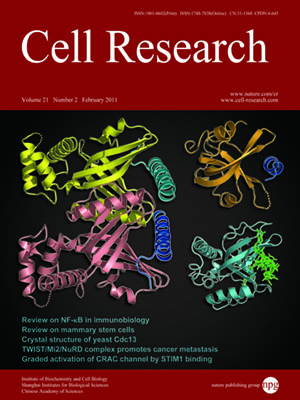
Volume 21, No 2, Feb 2011
ISSN: 1001-0602
EISSN: 1748-7838 2018
impact factor 17.848*
(Clarivate Analytics, 2019)
Volume 21 Issue 2, February 2011: 290-304
ORIGINAL ARTICLES
Neutrophil extracellular trap cell death requires both autophagy and superoxide generation
Quinten Remijsen1,2,3, Tom Vanden Berghe2,3, Ellen Wirawan2,3, Bob Asselbergh4, Eef Parthoens4,5, Riet De Rycke4, Sam Noppen4, Michel Delforge6, Jean Willems1,* and Peter Vandenabeele2,3,*
1IRC - Laboratory of Biochemistry, Department of Medicine, KU Leuven Campus Kortrijk, Kortrijk, Belgium
2Molecular Signaling and Cell Death Unit, Department for Molecular Biomedical Research, VIB, Ghent, Belgium
3Molecular Signaling and Cell Death Unit, Department of Biomedical Molecular Biology, Ghent University, Ghent, Belgium
4Microscopy Core Facility, Department for Molecular Biomedical Research, VIB, Ghent, Belgium
5Department of Biomedical Molecular Biology, Ghent University, Ghent, Belgium
6University Hospital Gasthuisberg, Department of Hematology, Leuven, Belgium
Correspondence: Peter Vandenabeele, Jean Willems,(Peter.Vandenabeele@dmbr.vib-UGent.be; Jean.Willems@kuleuven-kortrijk.be)
Neutrophil extracellular traps (NETs) are extracellular chromatin structures that can trap and degrade microbes. They arise from neutrophils that have activated a cell death program called NET cell death, or NETosis. Activation of NETosis has been shown to involve NADPH oxidase activity, disintegration of the nuclear envelope and most granule membranes, decondensation of nuclear chromatin and formation of NETs. We report that in phorbol myristate acetate (PMA)-stimulated neutrophils, intracellular chromatin decondensation and NET formation follow autophagy and superoxide production, both of which are required to mediate PMA-induced NETosis and occur independently of each other. Neutrophils from patients with chronic granulomatous disease, which lack NADPH oxidase activity, still exhibit PMA-induced autophagy. Conversely, PMA-induced NADPH oxidase activity is not affected by pharmacological inhibition of autophagy. Interestingly, inhibition of either autophagy or NADPH oxidase prevents intracellular chromatin decondensation, which is essential for NETosis and NET formation, and results in cell death characterized by hallmarks of apoptosis. These results indicate that apoptosis might function as a backup program for NETosis when autophagy or NADPH oxidase activity is prevented.
Cell Research (2011) 21: 290-304. doi:10.1038/cr.2010.150; published online 9 November 2010
FULL TEXT | PDF
Browse 2434


